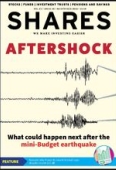Archived article
Please note that tax, investment, pension and ISA rules can change and the information and any views contained in this article may now be inaccurate.
I heard some pension funds were close to insolvency. Is mine safe?
Is my pension at risk? I’m a member of my company’s defined benefit scheme and have been reading stories suggesting they might be at risk of insolvency. Is there anything I could/should do?
Nathan
Tom Selby, AJ Bell Head of Retirement Policy, says:
Firstly, and most importantly, there is no need to panic or do anything.
Defined benefit, or DB, pensions pay a promised retirement income from a set age (your ‘normal pension age’). This income usually has at least some inflation protection built in, although in private sector DB schemes increases may be capped. The income you receive from your DB scheme will be based on the number of years you have been in the scheme and your salary.
In terms of what is currently happening, the thing to remember is that it’s the solvency of your employer that matters most when it comes to paying your pension. Provided your employer doesn’t go bust, it has a legal obligation to continue to stand behind the pension promises it has made.
Even where the sponsoring employer goes to the wall, the Pension Protection Fund or PPF exists as a safety net to ensure members get most of their promised retirement income.
The income you receive from the PPF if the sponsoring employer goes bust will depend on whether you have reached your scheme’s normal pension age or not.
Those who have reached their scheme’s normal pension age will receive 100% of their promised benefits. Those who have yet to reach their scheme’s normal pension age will usually get 90% of their benefits paid.
In most cases, PPF payments relating to pensionable service from 6 April 1997 will rise in line with inflation each year, subject to a maximum of 2.5% a year. Payments in relation to service before this date won’t increase, however.
SO…WHAT HAPPENED?
The decision by the Bank of England to buy £65 billion of UK Government bonds, or ‘gilts’, was in part driven by fears of a sell-off of gilts by pension funds. This fear was exacerbated by ‘hedging’ strategies lots of pension funds have in place.
When the interest rate or ‘yield’ on Government gilts rises, the accounting value of liabilities linked to DB schemes falls. So, in theory, the rising yields we have seen in recent weeks should have been good news for the funding position of DB pension schemes.
However, lots of DB schemes hedge interest rate risk using financial instruments. This just means these instruments aim to broadly cancel out the impact of gilt yield movements. If gilt yields rise, liabilities fall, and the financial position of the pension scheme improves. This will trigger a cash call from the investment bank operating the hedge.
This has caused a problem because of the speed at which gilt yields have risen. Schemes were going to have to sell down assets to pay cash to investment banks, but one of the main assets held by DB schemes is… gilts.
The risk the Bank of England tried to address last week was therefore of a further gilt sell-off – on top of what we had already seen – and additional instability in the UK economy.
DO YOU HAVE A QUESTION ON RETIREMENT ISSUES?
Send an email to asktom@sharesmagazine.co.uk with the words ‘Retirement question’ in the subject line. We’ll do our best to respond in a future edition of Shares.
Please note, we only provide information and we do not provide financial advice. If you’re unsure please consult a suitably qualified financial adviser. We cannot comment on individual investment portfolios.
Important information:
These articles are provided by Shares magazine which is published by AJ Bell Media, a part of AJ Bell. Shares is not written by AJ Bell.
Shares is provided for your general information and use and is not a personal recommendation to invest. It is not intended to be relied upon by you in making or not making any investment decisions. The investments referred to in these articles will not be suitable for all investors. If in doubt please seek appropriate independent financial advice.
Investors acting on the information in these articles do so at their own risk and AJ Bell Media and its staff do not accept liability for losses suffered by investors as a result of their investment decisions.
Issue contents
Feature
Great Ideas
- Ruffer delivers positive return in difficult times but sees more pain for investors
- Ideal time to invest in life sciences cheaply through this trust
- Essentra's transformation to a pure-play industrial supplier is now complete
- How Crestchic is powering up for a growth push and why now is a great time to buy
Investment Trusts
News
- Will Porsche shares surge like Ferrari or skid like Aston Martin?
- Resilient Greggs holds firm on outlook in good start for Roisin Currie
- FTSE 100 firms set for record cash return in 2022 but pressures are mounting
- Find out which stocks surged and slumped during a turbulent third quarter
- Why dollar strength and foreign exchange volatility is bad for stock markets

 magazine
magazine









